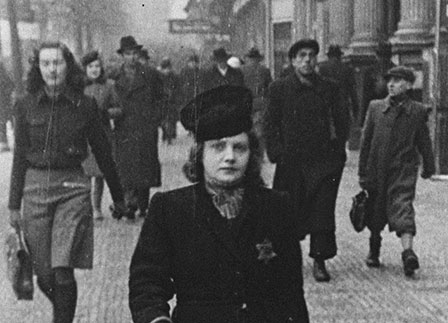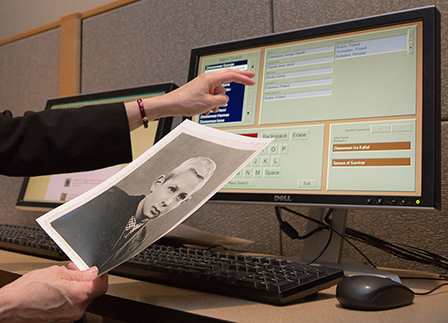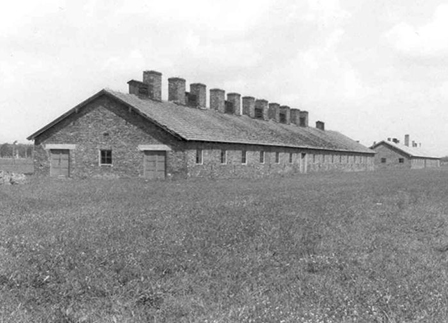Overview
- Brief Narrative
- Coupon with an exchange value of 5 marks of a type issued following World War I (1914-1918) by the local government of Moosch in the Haut Rhine in the Alsace region of France. The Treaty of Versailles, signed in 1919, made Germany return the Alsace and Lorraine regions to France. The regions had been German territory since the 1871 Franco-Prussian War. These coupons helped manage the currency transition. Located near the border of France, Switzerland, and Germany, the region's boundaries were contested for centuries. During World War II, the region was reclaimed by Nazi Germany in 1940 when it invaded France. After France was liberated in 1944, it was restored to French control. In 1945, the local language, Alsatian, a German dialect, was outlawed in schools.
- Date
-
issue:
approximately 1920-1921
- Geography
-
issue:
Moosch (France)
- Credit Line
- United States Holocaust Memorial Museum Collection, Gift of Barry Arnold Perlman, in the name of Louis Perlman
Physical Details
- Language
- German
- Classification
-
Exchange Media
- Category
-
Money
- Object Type
-
Emergency currency (lcsh)
- Physical Description
- Rectangular, discolored pink paper coupon with 3 perforated edges and an unperforated bottom left edge. It has black printed text with the denomination 5 Mark in the center. There is a line with the handwritten Gutschein (coupon) number, 677. It has a partial government seal stamped on the right. The back is blank. It is lightly creased with a few stains.
- Dimensions
- overall: Height: 2.250 inches (5.715 cm) | Width: 3.375 inches (8.573 cm)
- Materials
- overall : paper, india ink
- Inscription
- front, black ink : Gemeinde Moosch. / Gutschein Nr. 677 / 5 Mark Siegel. / Dieser Schein wird in bar eingelöst. / Der Bürgermeister, / Hoffmann [Municipality Moosch., Coupon Nr. 79, 10 Mark seal. This note will be redeemed in cash. The Mayor, Hoffmann]
front, left, stamp, border, purple ink : [A]LSACE) ✩ DE MOOSCH
Rights & Restrictions
- Conditions on Access
- No restrictions on access
- Conditions on Use
- No restrictions on use
Keywords & Subjects
- Topical Term
- Currency question--France--History--20th century. Foreign exchange--France--History--20th century. World War, 1914-1918--Economic aspects--France--Moosch.
- Geographic Name
- Alsace (France)--History--20th century. Alsace (France)--Economic aspects--History--20th century.
- Corporate Name
- Theresienstadt (Concentration camp)
Administrative Notes
- Legal Status
- Permanent Collection
- Provenance
- The coupon was donated to the United States Holocaust Memorial Museum in 1989 by Barry Perlman.
- Funding Note
- The cataloging of this artifact has been supported by a grant from the Conference on Jewish Material Claims Against Germany.
- Record last modified:
- 2022-07-28 18:21:08
- This page:
- http://collections.ushmm.org/search/catalog/irn903
Download & Licensing
In-Person Research
- By Appointment
- Request 21 Days in Advance of Visit
- Plan a Research Visit
- Request to See This Object
Contact Us
Also in Barry Perlman collection
The collection consists of seven pieces of scrip of the type issued in Theresienstadt ghetto-labor camp during World War II and four French currency exchange coupons of the type issued during World War I.
Date: approximately 1920-approximately 1943

Theresienstadt ghetto-labor camp scrip, 1 krone note
Object
Scrip, valued at 1 (eine) krone, of the type distributed in Theresienstadt ghetto-labor camp in German occupied Czechoslovakia beginning in May 1943. Inmates were not allowed to have currency. The SS camp administrators ordered the Jewish Council to design scrip for use only in the camp. It was issued to create a false appearance of normalcy and used as an incentive for forced labor. There was little to obtain with the scrip. Notes were printed in 7 denominations: 1, 2, 5, 10, 20, 50, 100. Located forty miles northwest of Prague, the camp was established by the Germans in November 24, 1941, and ceased operation in early May 1945, at the war's end. In 3.5 years, approximately 140,000 Jewish men, women, and children were transferred to Theresienstadt; nearly 90,000 were then deported, likely to their death further east. Conditions in the camp were terrible, and severe overcrowding, unsanitary conditions, and lack of food led to illness and starvation. About 33,000 Jews died in Theresienstadt.
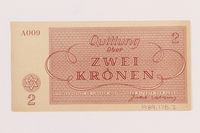
Theresienstadt ghetto-labor camp scrip, 2 kronen note
Object
Scrip, valued at 2 (zwei) kronen, of the type distributed in German occupied Czechoslovakia beginning in May 1943. Inmates were not allowed to have currency. The SS camp administrators ordered the Jewish Council to design scrip for use only in the camp. The notes were printed in 7 denominations: 1, 2, 5, 10, 20, 50, 100. It was issued to create a false appearance of normalcy. There was little to obtain with the scrip. Located forty miles northwest of Prague, the camp was established by the Germans in November 24, 1941, and ceased operation in early May 1945, at the war's end. In 3.5 years, approximately 140,000 Jewish men, women, and children were transferred to Theresienstadt; nearly 90,000 were then deported, likely to their death further east. Conditions in the camp were terrible, as severe overcrowding, unsanitary conditions, and lack of food led to illness and malnutrition. About 33,000 Jews died in Theresienstadt.
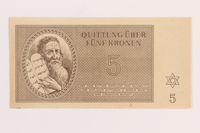
Theresienstadt ghetto-labor camp scrip, 5 kronen note
Object
Scrip, valued at 5 [funf] kronen, of the type distributed in German occupied Czechoslovakia beginning in May 1943. Inmates were not allowed to have currency. The SS camp administrators ordered the Jewish Council to design scrip for use only in the camp. The notes were printed in 7 denominations: 1, 2, 5, 10, 20, 50, 100. It was issued to create a false appearance of normalcy. There was little to obtain with the scrip. Located forty miles northwest of Prague, the camp was established by the Germans in November 24, 1941, and ceased operation in early May 1945, at the war's end. In 3.5 years, approximately 140,000 Jewish men, women, and children were transferred to Theresienstadt; nearly 90,000 were then deported, likely to their death further east. Conditions in the camp were terrible, as severe overcrowding, unsanitary conditions, and lack of food led to illness and malnutrition. About 33,000 Jews died in Theresienstadt.
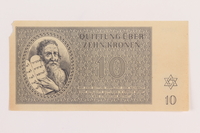
Theresienstadt ghetto-labor camp scrip, 10 kronen note
Object
Scrip, valued at 10 (zehn) kronen, of the type distributed in German occupied Czechoslovakia beginning in May 1943. Inmates were not allowed to have currency. The SS camp administrators ordered the Jewish Council to design scrip for use only in the camp. The notes were printed in 7 denominations: 1, 2, 5, 10, 20, 50, 100. It was issued to create a false appearance of normalcy. There was little to obtain with the scrip. Located forty miles northwest of Prague, the camp was established by the Germans in November 24, 1941, and ceased operation in early May 1945, at the war's end. In 3.5 years, approximately 140,000 Jewish men, women, and children were transferred to Theresienstadt; nearly 90,000 were then deported, likely to their death further east. Conditions in the camp were terrible, as severe overcrowding, unsanitary conditions, and lack of food led to illness and malnutrition. About 33,000 Jews died in Theresienstadt.

Theresienstadt ghetto-labor camp scrip, 20 kronen note
Object
Scrip, valued at 20 (zwanzig) kronen, of the type distributed in German occupied Czechoslovakia beginning in May 1943. Inmates were not allowed to have currency. The SS camp administrators ordered the Jewish Council to design scrip for use only in the camp. The notes were printed in 7 denominations: 1, 2, 5, 10, 20, 50, 100. It was issued to create a false appearance of normalcy. There was little to obtain with the scrip. Located forty miles northwest of Prague, the camp was established by the Germans in November 24, 1941, and ceased operation in early May 1945, at the war's end. In 3.5 years, approximately 140,000 Jewish men, women, and children were transferred to Theresienstadt; nearly 90,000 were then deported, likely to their death further east. Conditions in the camp were terrible, as severe overcrowding, unsanitary conditions, and lack of food led to illness and malnutrition. About 33,000 Jews died in Theresienstadt.

Theresienstadt ghetto-labor camp scrip, 50 kronen note
Object
Scrip, valued at 50 (funfzig) kronen, of the type distributed in German occupied Czechoslovakia beginning in May 1943. Inmates were not allowed to have currency. The SS camp administrators ordered the Jewish Council to design scrip for use only in the camp. The notes were printed in 7 denominations: 1, 2, 5, 10, 20, 50, 100. It was issued to create a false appearance of normalcy. There was little to obtain with the scrip. Located forty miles northwest of Prague, the camp was established by the Germans in November 24, 1941, and ceased operation in early May 1945, at the war's end. In 3.5 years, approximately 140,000 Jewish men, women, and children were transferred to Theresienstadt; nearly 90,000 were then deported, likely to their death further east. Conditions in the camp were terrible, as severe overcrowding, unsanitary conditions, and lack of food led to illness and malnutrition. About 33,000 Jews died in Theresienstadt.
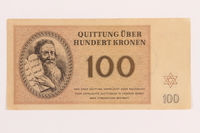
Theresienstadt ghetto-labor camp scrip, 100 kronen note
Object
Scrip, valued at 100 (ein hundert) kronen, of the type distributed in German occupied Czechoslovakia beginning in May 1943. Inmates were not allowed to have currency. The SS camp administrators ordered the Jewish Council to design scrip for use only in the camp. The notes were printed in 7 denominations: 1, 2, 5, 10, 20, 50, 100. It was issued to create a false appearance of normalcy. There was little to obtain with the scrip. Located forty miles northwest of Prague, the camp was established by the Germans in November 24, 1941, and ceased operation in early May 1945, at the war's end. In 3.5 years, approximately 140,000 Jewish men, women, and children were transferred to Theresienstadt; nearly 90,000 were then deported, likely to their death further east. Conditions in the camp were terrible, as severe overcrowding, unsanitary conditions, and lack of food led to illness and malnutrition. About 33,000 Jews died in Theresienstadt.
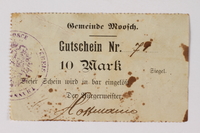
Moosch (Alsace), France, 10 mark currency exchange coupon nr. 79
Object
Coupon with an exchange value of 10 marks of the type issued following World War I (1914-1918) by the local government in Moosch in the Haut Rhine of the Alsace region of France. The Treaty of Versailles, signed in 1919, made Germany return the Alsace and Lorraine regions to France. The regions had been German territory since the 1871 Franco-Prussian War. These coupons helped manage the currency transition. Located near the border of France, Switzerland, and Germany, the region's boundaries were contested for centuries. During World War II, the region was reclaimed by Nazi Germany in 1940 when it invaded France. After France was liberated in 1944, it was restored to French control. In 1945, the local language, Alsatian, a German dialect, was outlawed in schools.
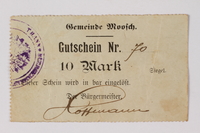
Moosch (Alsace), France, 10 mark currency exchange coupon 70
Object
Coupon with an exchange value of 10 marks of a type issued following World War I by the local government in Moosch in the Haut Rhine region in the Alsace region of France. The Treaty of Versailles, signed in 1919, made Germany return the Alsace and Lorraine regions to France. The regions had been German territory since the 1871 Franco-Prussian War. These coupons helped manage the currency transition. Located near the border of France, Switzerland, and Germany, the region's boundaries were contested for centuries. During World War II, the region was reclaimed by Nazi Germany in 1940 when it invaded France. After France was liberated in 1944, it was restored to French control. In 1945, the local language, Alsatian, a German dialect, was outlawed in schools.
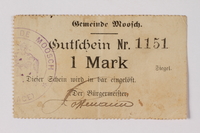
Moosch (Alsace), France, 1 mark currency exchange coupon 1151
Object
Coupon with an exchange value of 10 marks of a type issued following World War I by the local government in Moosch in the Haut Rhine region in the Alsace region of France. The Treaty of Versailles, signed in 1919, made Germany return the Alsace and Lorraine regions to France. The regions had been German territory since the 1871 Franco-Prussian War. These coupons helped manage the currency transition. Located near the border of France, Switzerland, and Germany, the region's boundaries were contested for centuries. During World War II, the region was reclaimed by Nazi Germany in 1940 when it invaded France. After France was liberated in 1944, it was restored to French control. In 1945, the local language, Alsatian, a German dialect, was outlawed in schools.

